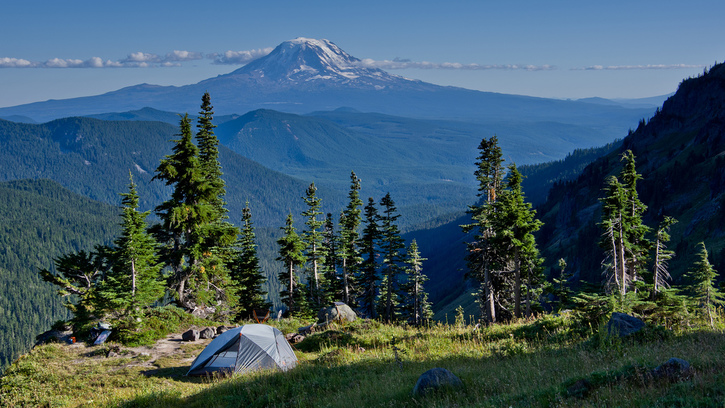Deciding to buy your first tent is really exciting. However, choosing the right tent for you can be a bit overwhelming. I will try to list some of the important things to consider when buying your new tent.
1. Budget
The first step is to set your budget. How much are you prepared to spend. Tent prices are vary from $100 to $1,500 or more depending on: brand, size, material and design. Try to get the best quality that you can afford.
2. Size
Tents come in a variety of sizes, depending on how many people it will sleep, how tall you are and the size of your pack. Make sure you check the tent measurements carefully. The size of the tent is usually related to the price and weight.
3. Purpose
If you planning to carry your tent in your pack for long distances, you want something that is light and can pack down small. If you are planning to camp at a campsite next to your car, weight won't be a problem.
4. Conditions
If you planning to camp in snow, you will need a four season or mountaineering tent. These kinds of tents are usually more expensive but are designed to survive severe weather conditions and keep you warm in very cold temperatures.
After you think about all those factors, it is time to look closely at the tents features.
1. Material
Compare the material between the tents. Some materials have more durability to UV exposure than others. This is important if you will mainly use the tent in unsheltered areas, like most campsites. Some tents are made of material that is resistant to fire, this will give you extra time to get out of the tent in the event of a fire or even better - not catch fire in the first place.
2. Waterproofing
Some materials are more waterproof than others, some have extra waterproof coatings. Check whether the seams are sealed or not.
3. Shape
Apart from its size, the shape of a tent is also important. As you will realise from the beginning of you tent hunting journey, there are various shape of tents, dome, tunnel, pyramid, etc. They all have advantages and drawbacks, for example tunnel tents may be suitable for windy weather but do not provide spacious head room. Some tents have irregular shapes and this could either provide more room or alternatively reduce available space.
4. Poling system
In my opinion, poles are the most important part of the tents because they are the structure that will shape your tent, and make sure it stands up to the elements. Pole arrangements affect the ability of tents to survive strong wind. The material the poles are made from will impact their durability and the weight. Poles that are connected together will make the tent easier to build.
5. Ventilation
Air flow is really important, it needs to be able to keep you cool in hot weather without making you cold when it's windy. Ventilation also helps to keep moisture inside the tent under control. Fully covered tents may seem to be a great idea for camping on windy and cold nights. However, without enough air flow you will get too hot in the day and moisture will be trapped inside during the night. This moisture will wear out your tent faster and tents without good air flow might shake more when the wind blows.
6. Extra features
The small extra features make each tent unique. Extra pockets or vestibule areas, holes for the electricity cords, and extra doors or ventilations will make you appreciate your tent more. These extras are not necessary but they might drive you to buy a particular tent.
My description above is not an expert opinion, but I believe that it will help people who are planning to buy their first tent. The outdoor suppliers always make improvements on their products, so I did not go into specific details because they always change over the time.
My final advice is, do go to the shop and build each tent after you have decided on the short-list because some tents are easier to build than others and you do not want to find this out in the worst possible conditions.
Please check out my post about my tent hunting experience here. Happy shopping!!!
1. Budget
The first step is to set your budget. How much are you prepared to spend. Tent prices are vary from $100 to $1,500 or more depending on: brand, size, material and design. Try to get the best quality that you can afford.
2. Size
Tents come in a variety of sizes, depending on how many people it will sleep, how tall you are and the size of your pack. Make sure you check the tent measurements carefully. The size of the tent is usually related to the price and weight.
3. Purpose
If you planning to carry your tent in your pack for long distances, you want something that is light and can pack down small. If you are planning to camp at a campsite next to your car, weight won't be a problem.
4. Conditions
If you planning to camp in snow, you will need a four season or mountaineering tent. These kinds of tents are usually more expensive but are designed to survive severe weather conditions and keep you warm in very cold temperatures.
After you think about all those factors, it is time to look closely at the tents features.
1. Material
Compare the material between the tents. Some materials have more durability to UV exposure than others. This is important if you will mainly use the tent in unsheltered areas, like most campsites. Some tents are made of material that is resistant to fire, this will give you extra time to get out of the tent in the event of a fire or even better - not catch fire in the first place.
2. Waterproofing
Some materials are more waterproof than others, some have extra waterproof coatings. Check whether the seams are sealed or not.
3. Shape
Apart from its size, the shape of a tent is also important. As you will realise from the beginning of you tent hunting journey, there are various shape of tents, dome, tunnel, pyramid, etc. They all have advantages and drawbacks, for example tunnel tents may be suitable for windy weather but do not provide spacious head room. Some tents have irregular shapes and this could either provide more room or alternatively reduce available space.
4. Poling system
In my opinion, poles are the most important part of the tents because they are the structure that will shape your tent, and make sure it stands up to the elements. Pole arrangements affect the ability of tents to survive strong wind. The material the poles are made from will impact their durability and the weight. Poles that are connected together will make the tent easier to build.
5. Ventilation
Air flow is really important, it needs to be able to keep you cool in hot weather without making you cold when it's windy. Ventilation also helps to keep moisture inside the tent under control. Fully covered tents may seem to be a great idea for camping on windy and cold nights. However, without enough air flow you will get too hot in the day and moisture will be trapped inside during the night. This moisture will wear out your tent faster and tents without good air flow might shake more when the wind blows.
6. Extra features
The small extra features make each tent unique. Extra pockets or vestibule areas, holes for the electricity cords, and extra doors or ventilations will make you appreciate your tent more. These extras are not necessary but they might drive you to buy a particular tent.
My description above is not an expert opinion, but I believe that it will help people who are planning to buy their first tent. The outdoor suppliers always make improvements on their products, so I did not go into specific details because they always change over the time.
My final advice is, do go to the shop and build each tent after you have decided on the short-list because some tents are easier to build than others and you do not want to find this out in the worst possible conditions.
Please check out my post about my tent hunting experience here. Happy shopping!!!


 RSS Feed
RSS Feed